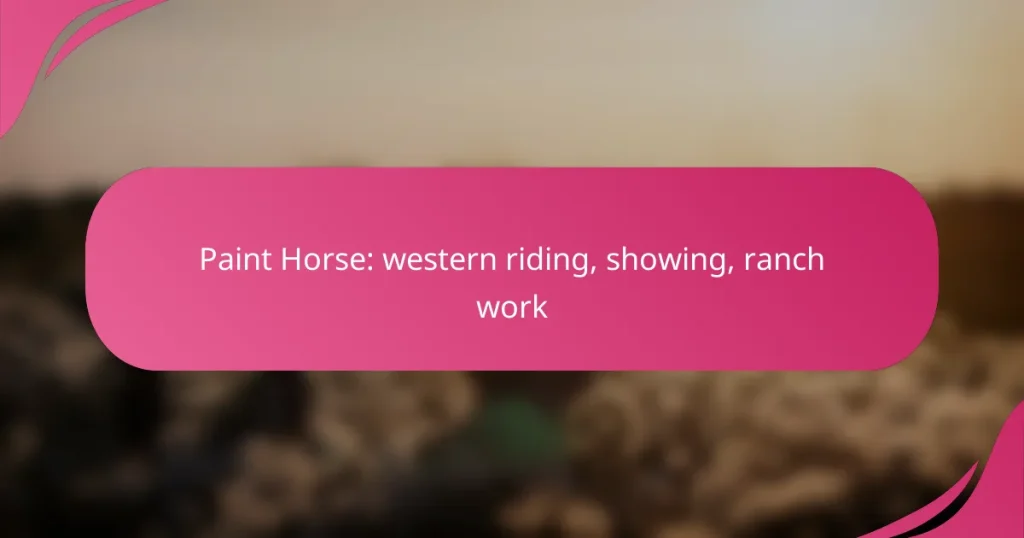Paint Horses are renowned for their striking appearance and versatile abilities, making them ideal for western riding, showing, and ranch work. Selecting the right Paint Horse involves considering their temperament, physical traits, and training needs to ensure they align with your riding goals. With proper training and care, these horses excel in various competitions, showcasing their unique skills and adaptability.

How to choose a Paint Horse for western riding?
Choosing a Paint Horse for western riding involves understanding the breed’s characteristics, temperament, physical attributes, health certifications, and lineage. Each of these factors plays a crucial role in ensuring the horse is well-suited for your riding needs and lifestyle.
Consider breed characteristics
Paint Horses are known for their distinctive coat patterns and versatility in various riding disciplines, particularly in western riding. They typically possess a strong build, good stamina, and an agile nature, making them suitable for ranch work and competitive events.
When selecting a Paint Horse, consider their conformation and movement, as these traits can significantly affect performance. Look for horses that exhibit a balanced structure and fluid gaits, which are essential for success in western riding.
Evaluate temperament and training
Temperament is a critical factor when choosing a Paint Horse for western riding. These horses should ideally be calm, willing, and responsive to their rider’s cues. A horse with a good temperament will be easier to train and handle, especially for beginners.
Assess the horse’s training level and experience. A well-trained Paint Horse will have a solid foundation in western riding techniques, making it more suitable for various activities, from trail riding to competitive shows.
Assess physical attributes
Physical attributes such as size, weight, and overall health are important when selecting a Paint Horse. Most Paint Horses range from 14.2 to 16.2 hands high, with a weight between 950 to 1,200 pounds. Ensure the horse’s size matches your own for better control and comfort.
Additionally, examine the horse’s muscle tone and body condition. A healthy Paint Horse should have a well-defined musculature and a shiny coat, indicating good nutrition and care.
Check for health certifications
Health certifications are essential to ensure the Paint Horse is free from common equine diseases. Look for documentation such as a negative Coggins test, which checks for equine infectious anemia, and vaccination records that confirm the horse is up-to-date on essential vaccines.
Consider having a pre-purchase veterinary exam conducted to assess the horse’s overall health and identify any potential issues that could affect its performance in western riding.
Review lineage and performance history
Understanding the lineage of a Paint Horse can provide insights into its potential performance and temperament. Research the horse’s pedigree to identify successful ancestors in western riding or ranch work, as this can indicate the horse’s capabilities.
Additionally, review the horse’s performance history in competitions or ranch work. A horse with a proven track record in western riding events is likely to be a more reliable choice for your riding goals.

What are the best practices for training a Paint Horse?
Training a Paint Horse effectively involves a combination of positive reinforcement, groundwork, consistency, and regular riding. These practices help develop a well-rounded, responsive, and confident horse suitable for western riding, showing, and ranch work.
Utilize positive reinforcement techniques
Positive reinforcement is a powerful training method that encourages desired behaviors through rewards. This can include treats, praise, or even a gentle pat when the horse performs correctly. By consistently rewarding good behavior, you create a positive association that motivates the Paint Horse to repeat those actions.
When implementing this technique, ensure that rewards are given immediately after the desired behavior to reinforce the connection. Avoid punishment, as it can lead to fear and anxiety, which are counterproductive to training.
Incorporate groundwork exercises
Groundwork exercises are essential for building trust and communication between you and your Paint Horse. Activities such as lunging, leading, and desensitization help establish a solid foundation before mounting. These exercises improve the horse’s responsiveness to commands and enhance its overall confidence.
Consider incorporating obstacles or challenges during groundwork to simulate real-life ranch scenarios. This prepares the horse for various situations it may encounter while working or showing.
Focus on consistency and patience
Consistency in training routines is crucial for a Paint Horse’s development. Use the same commands and cues each time to avoid confusion. Regular practice sessions, ideally several times a week, help reinforce learning and build muscle memory.
Patience is equally important; training can take time, and each horse learns at its own pace. Celebrate small progressions and avoid rushing the process to ensure a positive experience for both you and the horse.
Engage in regular riding sessions
Regular riding sessions are vital for reinforcing training and improving the horse’s skills. Aim for short, focused rides several times a week, gradually increasing duration and complexity as the horse becomes more comfortable. This helps maintain the horse’s fitness and responsiveness.
During riding, practice various maneuvers and techniques that are relevant to western riding and ranch work. This not only enhances the horse’s abilities but also strengthens the bond between rider and horse, making for a more enjoyable experience.

What are the key competitions for Paint Horses in the UK?
The key competitions for Paint Horses in the UK include western riding events, Paint Horse Association shows, and ranch horse versatility competitions. These events showcase the unique skills and characteristics of Paint Horses, emphasizing their versatility and suitability for various disciplines.
Western riding competitions
Western riding competitions focus on the horse’s ability to perform specific maneuvers and patterns, demonstrating both control and agility. Events typically include reining, barrel racing, and pole bending, where competitors navigate their horses through a series of obstacles. Riders must be skilled in guiding their horses smoothly and efficiently, making these competitions both challenging and entertaining.
In the UK, western riding competitions often take place at local shows and larger events, with classes for different skill levels. Participants should ensure their horses are well-trained and conditioned for the demands of these events, as performance can vary significantly based on the horse’s experience and the rider’s skill.
Paint Horse Association shows
Paint Horse Association shows are organized specifically for Paint Horses and focus on breed standards, conformation, and performance. These shows typically include halter classes, where horses are judged on their appearance, and performance classes, which assess their skills in various disciplines. Competitors can earn points toward championships and recognition within the breed.
To participate, owners must register their horses with the relevant Paint Horse Association and adhere to specific breed standards. It’s essential to prepare thoroughly for these shows, including grooming, training, and understanding the judging criteria to maximize success.
Ranch horse versatility events
Ranch horse versatility events test a horse’s ability to perform tasks commonly found on a ranch, such as cattle handling, trail riding, and obstacle navigation. These competitions are designed to showcase the horse’s versatility, responsiveness, and overall ranch skills. Participants often compete in multiple classes, demonstrating their horse’s capabilities across various scenarios.
In the UK, ranch horse versatility events are gaining popularity, and they typically attract a diverse range of competitors. Riders should focus on training their horses in real-world ranch tasks and ensure they are comfortable in different environments to excel in these competitions. Understanding the specific requirements of each class can also help competitors prepare effectively.

What are the benefits of owning a Paint Horse for ranch work?
Owning a Paint Horse for ranch work offers numerous advantages, including their versatility, strong endurance, and manageable temperament. These traits make them ideal for various tasks, from herding cattle to participating in rodeos.
Versatile working capabilities
Paint Horses are known for their adaptability in various ranch tasks. They excel in herding, roping, and even competing in rodeo events, making them valuable assets on any ranch. Their unique coloring and striking appearance also make them popular in showing and competitive settings.
When selecting a Paint Horse for ranch work, consider their training background and experience. A well-trained horse can handle multiple tasks efficiently, reducing the need for additional animals.
Strong endurance and agility
Paint Horses possess a natural athleticism that contributes to their endurance and agility. This makes them capable of covering long distances and maneuvering quickly, essential traits for ranch work that often requires speed and stamina.
Regular exercise and proper nutrition can enhance a Paint Horse’s endurance. Ensure they have a balanced diet and ample opportunities for physical activity to maintain their performance levels during demanding tasks.
Good temperament for handling livestock
The temperament of Paint Horses is generally calm and cooperative, which is crucial when working with livestock. Their friendly nature allows them to bond with both humans and animals, making them easier to handle during herding or sorting tasks.
When working with livestock, it’s essential to train your Paint Horse to respond well to commands and cues. Consistent training and positive reinforcement can help develop a reliable working relationship, ensuring safety and efficiency on the ranch.

What equipment is essential for Paint Horse showing?
Essential equipment for Paint Horse showing includes specific tack, grooming supplies, and appropriate attire for both horse and rider. Proper gear enhances performance and ensures compliance with show regulations.
Western Saddle
A western saddle is crucial for Paint Horse showing, providing comfort and security for both horse and rider. Look for a saddle that fits your horse well, as this can affect performance and behavior in the ring.
Ensure the saddle is equipped with a proper cinch and stirrups that allow for easy adjustments. Consider materials that balance durability and weight, as this can impact your riding experience during shows.
Bridle and Bit
The bridle and bit are vital for communication between horse and rider. Choose a bridle that fits comfortably and a bit that suits your horse’s training level and temperament.
Common options include snaffle bits for younger horses and curb bits for more experienced competitors. Always check local show regulations for specific bit requirements.
Grooming Supplies
Grooming supplies are essential to present your Paint Horse in the best light. Basic items include brushes, hoof picks, and mane combs, which help maintain coat health and appearance.
Consider using a good quality shampoo and conditioner to enhance the horse’s coat shine before a show. Regular grooming not only keeps your horse looking great but also fosters a strong bond between horse and rider.
Show Attire
Show attire for the rider should reflect professionalism and style. A well-fitted western shirt, jeans, and cowboy boots are standard, while hats and chaps can add a polished touch.
Ensure your attire adheres to the specific guidelines of the show you are entering, as some events may have strict dress codes. Pay attention to color coordination with your horse’s tack for a cohesive look.


